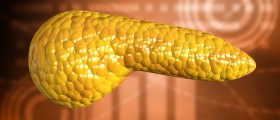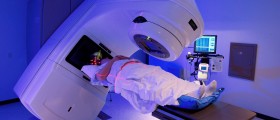Pancreatic tumors are termed as benign when they do not spread to surrounding tissues or distant body’s organs. Common types of a benign growth on the pancreas are cystic tumors and certain types of neuroendocrine tumors.
- Adenocarcinomas
- Neuroendocrine tumors
- Cystic tumors

Cystic Pancreatic Tumors
Cystic pancreatic tumors are also known as cystadenomas. These tumors develop on the surface of the pancreas. A cystadenoma is an uncommon type of pancreatic tumor that accounts for only 1 percent of all tumors of the pancreas. In fact, since 1981 when cystadenomas where first diagnosed, only 150 cases have been reported. Cystic pancreatic tumors most commonly affect younger females.
Types of cystic pancreatic tumors are mucionous cystadenoma, serous cystadenoma and mucinous ductal ectasia. Mucionous cystic neoplasms are the most common cystic tumors of the pancreas and are most often diagnosed in women around 54 years of age.
Pancreatic cysts appear like masses containing debris and that is a structural difference between cystadenomas and solid tumors of the pancreas. However, mucionous cystic neoplasms (MCNs) and neuroendocrine tumors of the pancreas have a tendency to turn into malignant masses. One study has shown that 64 percent of patients with mucinous cystic neoplasms had malignant tumors but most of them were treatable while 22 percent had metastasized to other parts of the body.
Insulinomas
Another common form of benign pancreatic tumor is the insulinoma of the neuroendocrine system. They rarely develop into cancer. An insulinoma affects insulin producing cells and is considered as a functioning tumor as it releases the hormone insulin. Insulinomas cause symptoms such as behavioral changes, hallucinations, confusion, weakness, tremor, fatigue, hunger and seizures. Individuals affected by inslinomas are often overweight because excess insulin produced by the tumor causes absorption of sugar by body cells.
Characteristics of Benign Pancreatic Tumors
Although benign pancreatic tumors do not have damaging features, they are not exactly harmless as they may become cancerous and cause bothersome symptoms. Benign tumors of the pancreas may lead to anemia, pain, decreased appetite, nausea and weight loss.
However, serous cystadenomas and mucinous cystic neoplasms are often asymptomatic. Because of this, these tumors are usually found incidentally during imaging tests done for other reasons. Even when discovered, they are often misdiagnosed as pseudocysts. This increases the risk of pancreatic cancer because patients with misdiagnosed cysts do not receive prompt and adequate treatment.
Therefore, to make a correct diagnosis doctors have to perform a biopsy of a pancreatic tumor using the guidance of CT scan. Surgical removal of benign pancreatic tumors is the preferred treatment option and these tumors rarely reappear after being removed.

















Your thoughts on this
Loading...